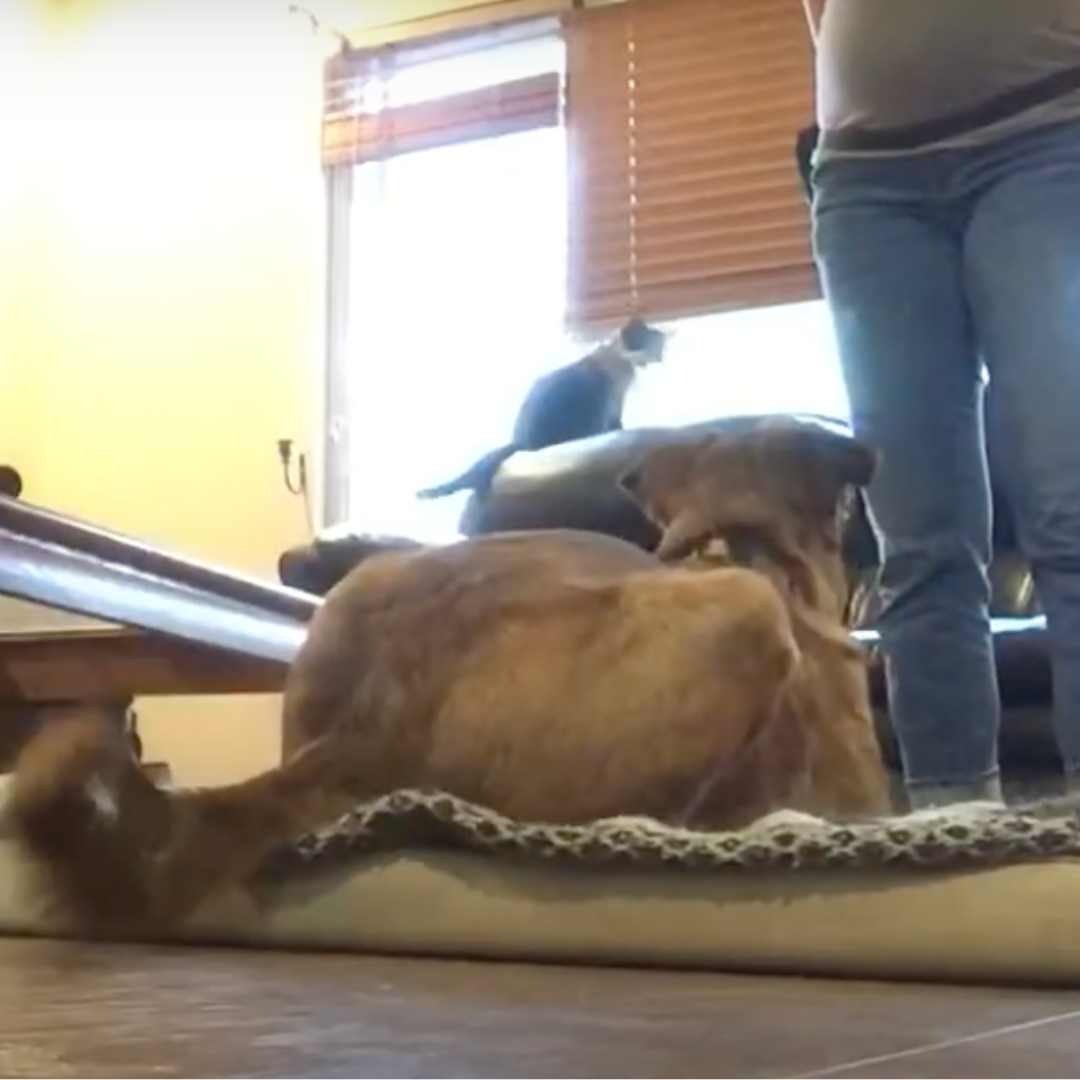You've been successfully training your dog to "go to bed" (or go to mat) - hooray for both of you! Take a moment to celebrate together!
And now that your dog understands the basics of "go to mat" training, you're ready to take this versatile cue to the next level and start mat training with the three D's (duration, distance, distractions). We want to make sure your dog's mat training will hold up as a behavior you can count on all the way from initial verbal cue to your release word in real-life situations. Here's how you can start training to achieve that.
How to train your dog's "go to mat or bed" for real life
The best starting point to solidify your dog's place behavior for real life is duration - probably the least beloved of the "three D's" to train. Why? Because building duration is kind of boring. It's not showy like being able to cue your dog to drop into a down from a football field away! BUT - it's so important.
Why it matters
In my experience as a certified professional dog trainer (and dog mom), having a solid foundation of duration, for most dogs, makes adding in distance and distraction much easier! If you're working on a distance stay, for example, there is inherently an element of duration already present, since as soon as your dog offers the place behavior he/she needs to stay calmly and hold position for however long it takes you to walk away and return.
We're going to talk about two different methods for building duration
They are not mutually exclusive, and actually complement each other nicely as you mat train your dog for the ultimate desired behavior - a rock solid "go to mat" cue you can bank on when you need it most (like when you're anticipating possible door dashing as the doorbell rings or counter surfing around mealtime).
If your dog already has a rock solid stay, you're ahead of the game, but stick with me, because we're also going to talk about how to build relaxation into the behavior. Most stays are pretty alert behaviors - your dog holds position, watching and listening carefully for the mark or release word. Being able to use the mat to kickstart a relaxed emotional state is a slightly different skill. Let's dive in.
Your Dog's Plan
Stop! Don't read this long article. Instead, get everything you need to know, including all advice on Go To Mat, in a customizable step-by-step plan for your dog created by our community of certified trainers and nutritionists.
Training method #1: delaying the click
Here's a chance to put your clicker training skills to work with some modified timing! You can see me practicing delaying the click once my dog has all paws on the mat in the video below.
It's similar to how you'd begin teaching your dog to build a stay - in small increments, delaying slightly before marking with your clicker and rewarding with high-value treats. Each repetition, you delay a little longer. (As always with this and other behaviors, you can use a verbal marker rather than a clicker, but your clicker is a better, more precise tool.)
Try this
Cue your dog to go to his/her mat. Count "one Mississippi, two Mississippi" in your head. (I do.) Click and treat toss away from the mat to reward your dog. Repeat increasing the duration between when your dog gets onto the mat and when you click.
Pro tip - don't increase the duration between paws on the mat and click every practice session. Throw in a few shorter/easier ones as well. This makes sure your dog doesn't get frustrated as the wait gets harder and harder, but instead stays engaged and focused on the game - and the treat reward.
Go To Mat
Interested in Go To Mat? Follow topics you're interested in to customize your dog’s step-by-step plan so it's most helpful and tailored to your dog when you're ready to get started.
Training method #2: catch your dog with his/her head down
I made a video of this exercise below - and honestly it's pretty boring, but that's kind of the point! Instead of marking/treating, I'm making magical goodies (high-value treats) rain from the sky when my dog's head is down. This may seem counter-intuitive at first - we spend so much time training our dogs to pay attention to us and offer eye contact! But for this exercise, we want to train your dog to settle in and chill out.
Okay, but tell me more...
By catching our dogs as they happen to have their head down, we're helping their body settle into a relaxed position on the dog bed or mat, and their state of mind is soon to follow. Giving a reward (high-value treat) when your dog shows this behavior naturally also is a perfect example of the shaping behavior we trained earlier in this "go to mat or bed" series!
And just as with the "delaying the click" method, you are gradually training your dog to go to bed and relax by decreasing your rate of reinforcement (how fast you are tossing treats). This not only helps capture the more relaxed state, but also helps magnetize your dog to the bed or mat until he/she eventually hears your release cue. Your dog never knows when something delicious may fall from the sky after choosing to lie quietly on the mat!
Try this
Cue your dog to go to the mat or bed. Once four paws are on the mat and your dog is in the down position comfortably, wait to catch your dog with his/her head down. Once you don't have eye contact, give your dog a treat on the mat. As long as your dog isn't looking at you keep cranking out the treats.
Added bonus
This is an easy game to play during whatever low-key thing you're doing. You can stand quietly, watch a movie, or do computer work as you practice this behavior. Part of the beauty of this mat training work is that our dogs don't need to feel our attention is 100% on them the whole time.
The end goal of the stationing behavior is to use this behavior during real-life stuff that happens every day in your house like feeding a baby, kid-play on the floor, or entertaining friends. So being reinforced for going onto the mat and offering behaviors that signal relaxation without someone staring at your dog is perfect for developing this skill!
Manners
Need more advice? Browse all guides in the Manners Channel on topics like Go To Mat, Food Manners, Party Manners, Stay, Public Manners, Travel Manners, and Basic Manners - created by our community of certified experts for you and your dog.
At any point, take a break with your dog and always keep it fun!
Trying to teach your dog to quietly lie down on a mat or bed and stay put can be oddly exhausting. Training is always supposed to be fun for both of you, so keep all your sessions short, take a break whenever you're stuck by giving your release cue and quickly start offering treats galore as a reward.
Learn how to elevate your dog's 'go to mat' training by mastering duration, the first of the three D's (duration, distance, distractions) in this video.
Choose how you'd like to view this guide's video.

Next up in the Manners Channel on Dogly
If you have any questions on adding duration to your mat training (or ANYthing mat training related), please ask them in the Community discussion in the Manners Channel!
And coming up in part four and five of teaching your dog to go to bed/mat, the next two D's - how to increase distance and add distractions when you ask your dog to calmly enjoy some time on his/her bed or mat.
Continue your go to mat training in the next guide or if you need more personalized help, sign up to work with me 1-1!

